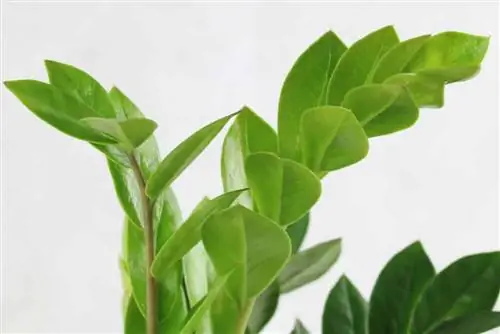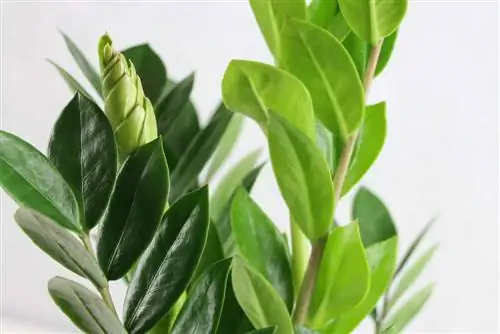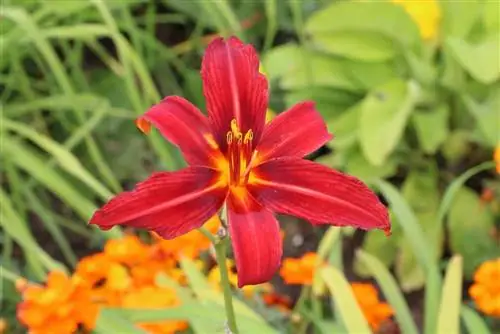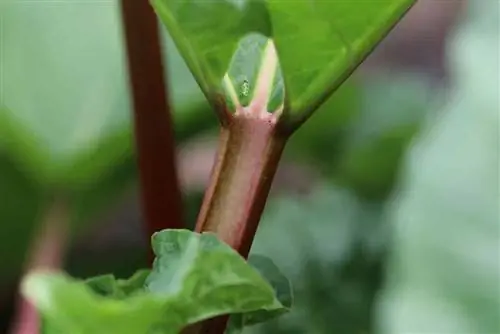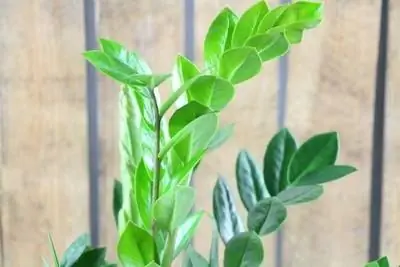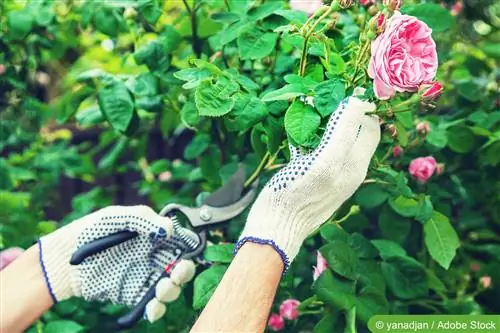- Author admin [email protected].
- Public 2023-12-17 03:39.
- Last modified 2025-01-24 12:45.
The Zamioculcas, which belongs to the arum family, is a popular decorative foliage plant in the living room. It does not require much care and is therefore also suitable for inexperienced indoor gardeners. In the right location and with the right soil, it can grow up to 90 cm high and therefore requires a little space on the windowsill.
The Toxicity
As an arum plant, Zamioculcas is a poisonous plant and a certain degree of caution is therefore required. The plant contains oxalic acid and calcium oxalate, which are also present in the water that may collect in the planter. Pets should not be allowed to drink it. Even curious small children should not be allowed near the plant, although life-threatening poisoning from the poisons of the lucky feather is not known.
The following symptoms of poisoning can occur:
- Redness and swelling upon contact with skin and mucous membranes
- burning feeling on the skin after contact
- Difficulty swallowing when ingesting plant parts through the mouth
- If parts are swallowed, gastrointestinal problems may occur, such as diarrhea and vomiting
- Eating parts of the zamie can lower the calcium level in the blood serum, which can also damage the kidneys
Treatment by a doctor is only necessary in rare cases, as children and animals usually spit out the bitter leaves immediately.
The following first aid measures are recommended:
- Eye wash if plant sap has penetrated
- If you swallow parts of a plant, drink a lot, the amount of liquid dilutes the poison
- Visit a doctor if there is no improvement in the short term
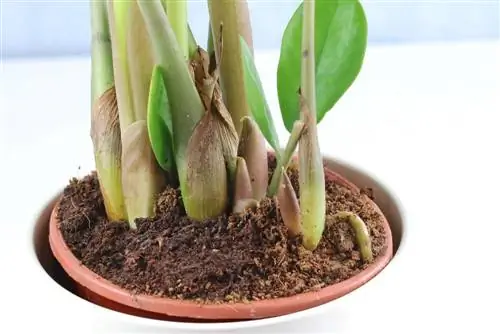
Animals that come into contact with the lucky feather or eat parts of it show the same symptoms as humans. Here, too, the vet should be consulted if the symptoms of poisoning do not improve after a short time.
Tip:
Wear gloves when handling the Zamioculcas. This means the skin cannot be irritated. Work with the necessary caution.
Cultivation
Only one leaf with seven to fourteen leaflets sprouts from tuberous, underground rhizomes. Here the lucky feather stores water for dry times. Flowers are rare in Zamie. However, once a flower develops, a white bulb, similar to that of the arum, sprouts from a bract.
The Location
A place in partial shade where the midday sun cannot reach is perfect for the Zamioculcas. It is content with a little morning or evening sun to thrive. It cannot tolerate blazing sun. Therefore, a very sunny location should be shaded with a cloth or something similar. If the Zamie is in direct shade, you will notice slower growth and a darker green color of the leaves.
However, the lucky feather is not damaged in such a place. So that she feels comfortable in her environment, the room temperature should be between 18 and 25 degrees. Only in autumn and winter, when the plant is going through its resting period, can it be a little cooler, but the temperature should not fall below 16 degrees.
The potting soil
A Zamie is ideally planted in loose potting soil that has been enriched with compost. The soil must be well-drained and may only have a pH of no more than 6.5. A little sand, clay or clay granules in the potting soil has a positive effect on the growth of the lucky feather. These additives prevent waterlogging and keep the potting soil loose and permeable. If you don't want to mix it yourself, cultivate the Zamie in special palm soil, because potting soil from the supermarket molds quickly.
Watering and fertilizing
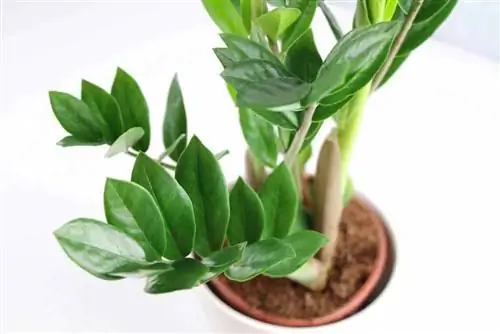
The easy-care Zamioculcas zamiifolia is content with small but regular watering. The soil surface in the flower pot should be allowed to dry a little before the next dose. Beginners in indoor gardening occasionally forget to water. This is not a tragedy with the Glücksfeder. Thanks to its fleshy rhizomes, where it stores water, it can survive a “dry season” without any damage. However, waterlogging should be avoided in any case.
If the Zamie is too wet, its leaves turn yellow and its individual stems can rot. Zamioculcas zamiifolia has relatively low nutrient requirements. In the spring, when the plant sprouts, you can supply it with a normal liquid fertilizer every four weeks.
The rest period
From late autumn onwards, the Zamie enters a resting period. It now requires cooler temperatures and less water. She feels comfortable in the bedroom, with enough light and a room temperature that is not below 16 degrees. Your ball of soil can safely dry out in the upper third before the next watering. However, if the lucky feather becomes too dry, it will shed its leaves. New shoots will not form until next spring. Fertilizing can be completely avoided during the dormant phase.
Repotting and dividing
Once the lucky feather has completely filled its pot with rhizomes, it's time to give it a new planter with fresh soil. The best time for this is March or April, when the plant sprouts again. If you want, you can now share the Zamie. Carefully cut them into two or three pieces with a sharp, clean knife, remove the old soil and replant each plant in fresh, compost-containing potting soil.
Propagation with leaf cuttings
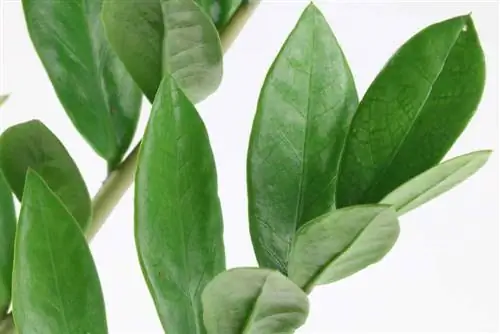
When repotting, the plant can also be propagated. To do this, you can cut leaf cuttings from the mother plant. Individual leaflets are carefully separated, placed vertically in nutrient-rich soil and watered moderately. After several months, new rhizomes and fresh shoots develop in the soil.
Propagation step by step
- choosing a he althy feather leaf
- carefully cut off with a sharp knife
- Provide a container with potting soil
- Put the leaf into the ground with the cut edge first (1 cm deep)
- pour on
- Place the cutting in partial shade at a room temperature of around 22 degrees
- regular watering
Plant pests
The spider mite
If the lucky feather is in a room with dry and very warm heating air, it can happen that spider mites settle, especially in the winter months. An infestation can be easily recognized by fine spider webs between the leaf axils and pinnacles. The plant must now be quarantined immediately so as not to infect other houseplants. Spider mites are controlled with commercially available insecticides for watering or spraying.
Tip:
If you don't want to use chemicals, you can get rid of spider mites with an old home remedy. The Zamie is first showered and then wrapped in a transparent film or bag that is sealed airtight. After a few days the film can be removed; the spider mites will then have died.
The Red Spider
If a fine web appears on the leaves of the lucky feather and its leaves turn yellow, gray-green or even red-brown, there is an infestation with the red spider. To combat the unwanted insect, the plant is first showered thoroughly, including the undersides of the leaves. Then the zamie must be sprayed with a suitable pesticide. If you don't want to spray, use a systemic control agent that is added to the irrigation water.
The plant absorbs the active ingredients through the water through its roots. In this way, the insecticide is distributed throughout the plant. All sucking pests are reached this way and they die. Depending on the infestation, the procedure must be repeated several times.

